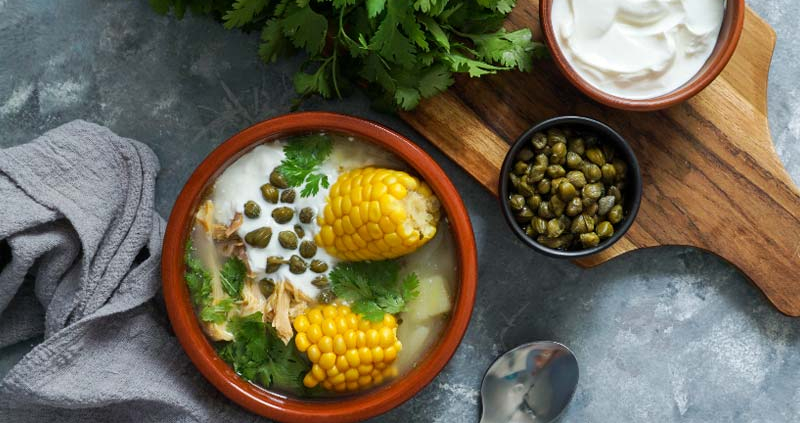Learn about Colombian food while improving your Spanish language
How would our life be without food?
How would traveling be without trying local dishes?
And, how would Colombia be without its flavors?
As Anthony Bourdain said:
“I think food, culture, people and landscape are all absolutely inseparable.”
The culture of a society is manifested in a variety of ways such as art, music and food. There is so much to learn by exploring the gastronomic richness of the countries.
Gastronomy (gastronomía in Spanish) is the study of the relationship between food and culture. It’s the art of preparing and serving rich or delicate and appetizing food. It’s the cooking styles of particular regions and the science of good eating.
If you love food and if you are interested in Colombian culture, then this post is for you!
What foods are popular in Colombia?
Colombia is a gastronomical paradise due to its natural and cultural diversity. Our food is a blend of different traditions. It is a blend of indigenous, Spanish, African and Arab flavors.
Each region has its own traditions and its own food. It would take some time -and many trips around the country- to try the flavors of each region.
But, if you want to have a taste of all Colombian regions in one place, then Bogota is your city!
Bogota is known as the gastronomic capital. It offers the opportunity to enjoy the flavors of Colombian, international and fusion cuisine. It’s not a surprise then that Bogota is one of Latin America’s major emerging culinary hotspots.
That’s why Netflix has included the city in the new series “Street Food Latin America”
What are the most popular Colombian dishes?
Colombian food is colorful, diverse and rich in flavor.
If you want to eat like a Colombian, make sure you try these 10 traditional dishes:
- Ajiaco
- Bandeja Paisa
- Sancocho
- Patacones
- Arepas
- Chocolate con queso
- Aguadepanela
- Salpicón
- Tamal
- Buñuelos
Also, make sure you go to the city’s local markets and try these 15 exotic fruits. You will understand why Colombia, and especially Bogota, is known as a gastronomical paradise.
How to learn Spanish through food?
What if we told you that you can learn Spanish through food?
Yes, it sounds amazing – and delicious-, isn’t it?
Trying new food is not only delicious but an opportunity to learn about new cultures and to learn new languages.
In Colombia, food connects people. When you come to visit Colombia you will have the opportunity to share time with locals while trying new dishes. You will be invited to join family and friends dinners, to visit local markets, and to try street food.
So, while you wait until it is possible to travel again you can learn Spanish online. It will not only keep you busy and motivated during COVID times, but it will prepare you for your next trip to Colombia.
Spanish food vocabulary
If you want to have a deep and meaningful experience, you should learn how to communicate with locals with regards to food.
Here we have prepared a short guide to help you learn the basics of Spanish food vocabulary:
Useful Vocabulary
- To eat (Comer)
- To drink (Beber or Tomar)
- Breakfast (Desayuno)
- To have breakfast (Desayunar)
- Lunch (Almuerzo)
- To have lunch (Almorzar)
- Dinner (Cena)
- To have dinner (Cenar)
- Snack (Merienda)
- To snack (Picar)
Fruits (Frutas)
- Apple (Manzana)
- Banana (Banano or Plátano)
- Grapes (Uvas)
- Lemon (Limón)
- Lime (Lime)
- Orange (Naranja)
- Peach (Durazno)
- Pear (Pera)
- Pineapple (Piña)
- Plum (Ciruela)
- Raspberry (Frambuesa)
- Strawberry (Fresa)
- Watermelon (Sandía or Patilla)
Vegetables (Verduras o vegetales)
- Asparagus (Espárragos)
- Broccoli (Brócoli)
- Carrot (Zanahoria)
- Cucumber (Pepino or pepino cohombro)
- Garlic (Ajo)
- Lettuce (Lechuga)
- Peas (Arvejas or Guisantes)
- Pepper (Pimiento or Pimentón)
- Potatoes (Papas)
- Spinach (Espinaca)
- Tomato (Tomate)
- Onion (Cebolla)
Meats (Carnes)
- Bacon (Tocineta)
- Beef (Carne de vaca)
- Chicken (Pollo)
- Duck (Pato)
- Ham (Jamón)
- Lamb (Cordero)
- Pork (Cerdo)
- Sausage (Salchicha)
- Steak (Bistec)
- Turkey (Pavo)
- Veal (Ternera)
Drinks (Bebidas)
- Beer (Cerveza)
- Coffee (Café or Tinto)
- Juice (Jugo)
- Milk (Leche)
- Soda (Soda o Gaseosa)
- Tea (Té)
- Tap Water (Agua de la llave)
- Mineral Water (Agua mineral)
- Red Wine (Vino tinto)
- White Wine (Vino blanco)
What does Sobremesa mean in Colombia?
Another important word is “Sobremesa”. This word doesn’t have a specific translation but it’s very important in Colombia.
Literal translation: “Over-table”
Slang meaning: In Colombia it refers to the drink that comes with the meal.
When you go to a restaurant, the waiter normally asks you:
2¿Qué desea tomar de sobremesa?”
What would you like to drink with your meal?)
While in Spain it refers to the action of spending time relaxing after a meal. It could be drinking coffee or just hanging out chatting at the table after eating.
If you want to know the main differences between Spanish from Colombia and Spanish from Spain read our post: “ Top 5 differences between Spanish from Colombia and Spanish from Spain”
Useful sentences and expressions in Spanish related to food
- I’m hungry (Tengo hambre)
- I’m thirsty (Tengo sed)
- May I have the menu, please? (Podría ver el menú, por favor?)
- What do you recommend? (Qué me recomienda?)
- I would like… (Quisiera…)
- May I have some…? (Podría traerme…)
- Nothing more, thanks (Nada más, gracias)
- Without….. please (Sin…. por favor)
- I’m vegetarian (Soy vegetariano/a)
- Can I have the bill, please? (Me regala la cuenta, por favor)
We hope you have enjoyed the reading. If you want to learn and improve your Spanish language from home join our online classes. And, if you want to learn more about Colombian culture don’t forget to read our weekly blog.










